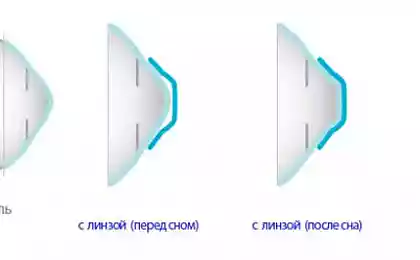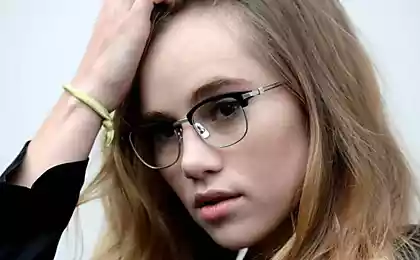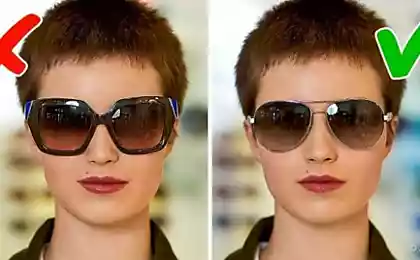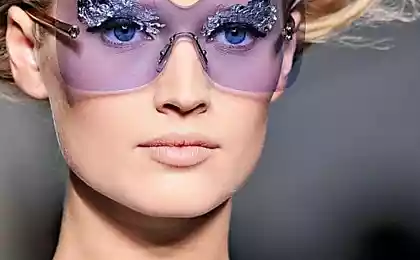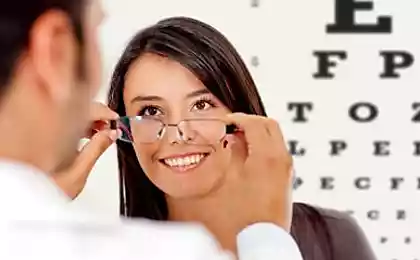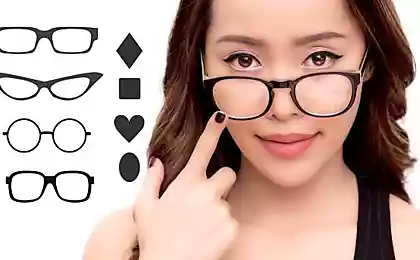757
Ancient optical lenses for more than a century was not noticed by the archaeologists!
More than a century they were not noticed by the archaeologists. We are talking about optical lenses — delicate instruments, made of different materials, which prove the existence of a developed optics already in antiquity.
There was able people several thousand years ago to make an accurate optical instruments, by which it is possible to correct astigmatism, to observe a distant star and work on a microscopic level?
An expert on ancient lenses Robert temple (famous for his book on the cosmic knowledge of the Dogon tribe "Mystery of Sirius") I'm sure not just that, but also that the evidence is so unexpected assumptions were specialists on hand for at least a hundred years.

All of the past three decades Robert, showing superhuman perseverance and to develop its own specific methods of work, rushed down the light, having found out during trips, in museums there is a huge amount of items mistakenly written as jewelry, beads, etc. But their real purpose was quite different — to increase the visibility of distant or microscopic objects, to focus the sunlight to produce fire and even for orientation...
The first surprise for the researcher was, he wrote in his monograph "the Crystal sun", which in the classical texts, as well as in oral cultural and religious traditions of the many peoples have many references to the existence of these optical devices. These instructions could have a long time to attract the attention of historians and archaeologists, causing them the desire to find the described devices.
However, as with bitterness is recognized in the scientific community has developed a negative tradition, which denies the possibility of the existence of any developed technologies in ancient times. For example, some items whose shape and material inevitably suggests that they served as lenses, were classified as mirror, earrings or, at best, like a burning glass, that is all the same lenses, but used exclusively to focus sunlight and ignition of fires.
Paradoxically small crystalline sphere, produced by the Romans and used by them as a lens when filled with water, were painted as vessels for cosmetics and perfumes. In both cases, according to Robert, highlighting the special myopia of modern science, which he intends to write good points.
Miniature models of time of Pliny
Ancient references to lenses relatively easily traced since the time of Pliny the Elder (I century), although, as we shall see, such instructions can be found in the "pyramid Texts", which are more than 4000 years, or even earlier — in the same Ancient Egypt.
In his "Natural history" Pliny describes this laborious work with miniature objects, which is engaged in Calibrat and Mermaid, two Roman artist and craftsman, approximately in such words: "Callicrate was able to produce models of ants and other tiny creatures, whose body parts remained invisible to other people. Mermaid deserved fame in the same field, making a small wagon with four horses from the same material, so tiny that it could close its wings fly, and the same size ship."
If the stories of Pliny are impressive, it is no less concerned about the mention of a miniature copy of the "Iliad", made on such a small piece of parchment that the whole book could fit in a nutshell, what the first says Cicero, the author of the previous century. Closer to us, the more classical authors include in their works data on these now lost items, which obviously required the use of optical devices.
According to temple, "author of the first modern optical instruments — except magnifying glass — was the Italian Francesco Vettori, which in 1739 was created microscope. Vettori, was a connoisseur of antique gems, and said that he saw some of them the size of a half grain of lentil, which, however, was skillfully handled what he believed to be impossible if you don't acknowledge that the ancient was a powerful magnifying devices."
It was while working with ancient jewelry, it becomes apparent that there is now lost optical technology.
It intuitively pointed by many experts for several centuries, however, this fascinating area of the history of science somehow remained completely unexplored.
Carl Sill, German art historian, in 1895 argued that there was a portrait on the stone with a diameter of just 6 mm Dam of Pompeii, wife of Roman Emperor Trajan, who lived in the first century. Settl pointed to him as an example of the use of optical means to increase the ancient carvers.
In the historical Museum of Stockholm and the Shanghai Museum houses artifacts from various metals such as gold or bronze, on which are clearly visible miniature work, as well as numerous clay tablets from Babylon and Assyria visible extruded microscopic cuneiform signs.
These tiny inscriptions were so numerous, especially in Greece and Rome that Robert Temple had to abandon the idea of all of them to find and classify. The same is true for the lenses, which he had hoped to find more than a few pieces, but in the English edition of his book, leading as many as 450!
As for glass spheres, used as a burning glass and burning wounds, they also preserved many in various museums, despite its fragility, but have always been classified as vessels for storage of special fluids.
From death rays to ancient Egyptian optics
What optical technologies of antiquity are not at all an illusion, "illusion", you can understand, if you carefully reread the classics, a good poryskat in Museum catalogues and to reinterpret some of the myths. One of the most obvious examples of the last field is the legend of the divine fire which gave people different characters, as it happened with Prometheus, just enough to accept that people had the tools "to fire out of nowhere."
The Greek author Aristophanes actually says directly in his Comedy "the Clouds" on the lens, which kindled a fire in the V century BC, the same thing could be done, apparently, and druids. They used the transparent minerals in order to identify "invisible substance of fire."
But the most striking application of this technology we meet Archimedes, with its giant mirrors. No need to remind here about all the scientific contribution of this genius, born in Syracuse and lived from 287 in 212 BC, However, necessarily need to say that during the siege of Syracuse in the year 212 the Roman fleet of Claudius Marcellus, Archimedes was able to set fire to Roman Trier, focusing and directing to the sun's rays through the enormous, presumably metal mirrors.
The veracity of this episode has traditionally been questioned until 6 November 1973, while Ioannis Sakes do not repeat it in the port of Piraeus and with 70 mirrors set fire to a small ship.
Evidence of this subsequently forgotten knowledge is found everywhere, exposing the fact that the life of the ancient people was much richer and more creative than sometimes able to recognize our conservative mind. It is here better than anywhere else, justified the old adage that the world is depending on the color of glass through which we look at him.
Another important finding, which introduces us temple, it is the fruit of hard work in the field of bibliography and Philology. They dedicated their time Dr. Michael Weitzman from the University of London, he showed that the term "totafot" which is used in the biblical Books of Exodus and Deuteronomy to refer to the phylacteries, fixed to the forehead during religious services, was originally called an object, which is placed between the eyes.
And the result is in front of us another description of points, and, according to Weitzman, the best expert on ancient Jewish history in England, points that originate from Egypt.
There is nothing strange that in the land of the pharaohs was familiar with them even before there were actually pharaohs. Because the only way to explain the presence of microscopic patterns on the handle of a knife of ivory, which is found in the 1990-ies Dr. Gunter Dreyer, Director of the German Institute in Cairo, the cemetery of Umm-El-KAB (Umm el-Qaab) in Abydos.
Surprising that the knife dates back to the predynastic era, the so-called "period Nagada-II", that is, about XXXIV century BC — in Other words, it was made 5300 years ago!

The knife from Umm el-Qaab thumbnail incredible precision on the handle
This is a real archaeological mystery is for us — that can only be assessed with a magnifying glass, — a series of human figures and animals, whose head does not exceed one millimeter.
Temple, apparently, absolutely convinced that optical technology appeared in Egypt and was used not only in the manufacture of miniature images in everyday life, but also in the construction and orientation of buildings in the Ancient Kingdom, and also for producing different lighting effects in the temples by a polished disc and in the calculation time.
False eyes of statues IV, V and III dynasties were "convex crystal lenses, perfectly processed and polished", they increased the size of the pupil and gave the statues animated.
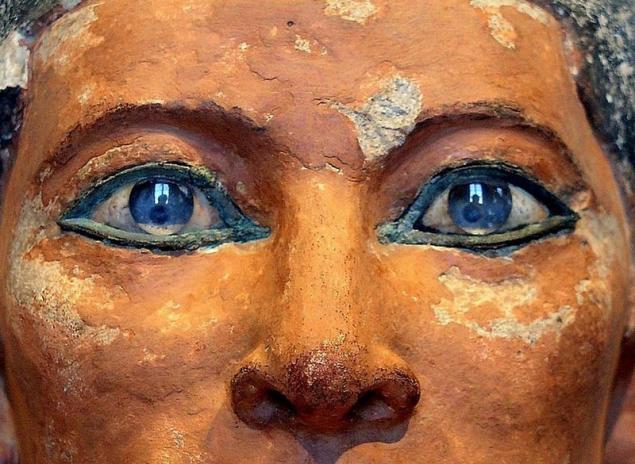
In this case, the lenses were made of quartz, and evidence of its abundance in Ancient Egypt in large numbers can be found in museums and books on Egyptology. Thus, it appears That the "Eye of Horus" was another type of optical device.
Lens Layard and other
The prototype of an extensive series of evidence collected Temple, was a lens Layard.
This stone is at the beginning of his thirty-year epic, and because of the enormous value that it represents for the extensive revision history is kept in the Department of Western Asian antiquities at the British Museum.
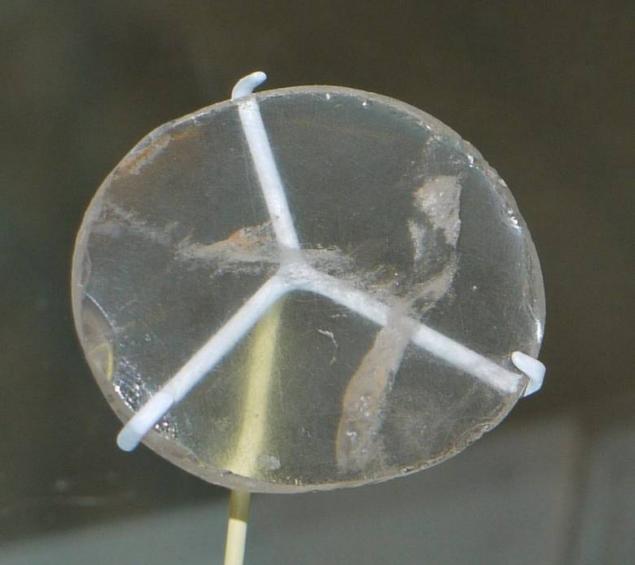
Layard lens (the same lens the Nimrud)
The lens was found during excavations made by Austin Henry Laiagam in 1849 in Iraq in one of the halls of the Palace in Kalhu, also known as the city of Nimrud. It is only part of a complex of finds, which includes a huge number of items that belonged to the Assyrian king Sargon, who lived in the VII century BC.
We are talking about the subject of rock crystal, ellipsoidal, 4.2 cm in length and 3,43 cm wide, with an average thickness of 5 millimeters.
Initially, this lens was a frame, perhaps made of gold or other precious metal, fitted with great care, but she was kidnapped and sold working with dig. However, the most amazing thing is that we are talking about this PLANO-convex lens, which was carved in the shape torroid, absolutely incorrect in the opinion of the layman, with numerous slits on a flat surface. It is absolutely obvious that it was used for correction of astigmatism. So peep the graduations on the lens is different in different parts, from 4 to 7 units, and levels increase diopter range from 1.25 to 2.
The manufacture of such a device required a high precision. First, the surface was completely flat on both sides and had perfect transparency — a quality that, of course, now largely lost due to numerous cracks, dirt, clogged in the micropores, and other effects will inevitably leave their marks on the artifact antiquity of 2.5 thousand years.
It is significant that the lens has the eyeball and even the same settings with some modern standard lenses.
When the temple came across the story of this lens and completed its analysis, began its work, which led today to the identification and study of more than 450 lenses all over the world. The discoverer of Troy Schliemann found 48 lenses in the ruins of the mythical city, one of which is particularly distinguished by the perfection of manufacture and traces of acquaintance with the tools of the engraver.
In Ephesus found as many as 30 lenses, and, tellingly, they were all concave and reduced the image to 75 percent, and in Knossos, Crete, as it turned out, the lenses produced in such quantities that even managed to find a real Studio Minoan for their production.
In the Cairo Museum instance round lens the III century BC, five millimeters in diameter, preserved in excellent condition and increase 1.5 times.
In Scandinavian countries the number of discovered ancient lenses close to one hundred, and on the ruins of Carthage they found 16 — all PLANO-convex, all of the glass, with the exception of two, made of rock crystal.
It is obvious that after the book "the Crystal sun" and its translation into other languages will be found the new lens, burning glass, "smaragds" and other evidence of the optical art of antiquity, without any sense becoming dusty in museums for decades or even centuries.
However, we should not see these certificates traces in our Land of aliens, or the existence of some forgotten civilizations with extremely advanced technology. They simply indicate normal evolutionary development of science and technology, based on the study of nature by means of accumulation of empirical knowledge through trial and error.
In other words, we have a testimony of the ingenuity of the human genius, and only people in the response as for the occurrence of such miracles, and oblivion.
Millennial glasses
We already know that the biblical term "totafot" was probably of Egyptian origin and meant a subject similar to our glasses. However, the best example of the use of glasses in ancient times gives us the infamous Nero, about which the same Pliny provides comprehensive information.
Nero was short-sighted and, in order to observe Gladiator fights used "smaragds" pieces of green crystal, not only to correcting vision defects, but also visually pribezhavshie objects. We are talking about the monocle, which, quite possibly, kept on a metal stand, and his lens was probably made of green gems such as emerald or convex-faceted glass.
In the last century experts have discussed a lot on the topic of myopia of Nero and came to the conclusion that the invention of means for adjustment of two thousand years ago it is possible, in contrast to the traditionally accepted view about the appearance of points in the XIII century.
Temple concludes: "the Ancient glasses, which, in my opinion, was very much was a form of pince-nez, fixed to the nose, or the kind of fear that from time to time brought to the eyes".
As for the question, were they or not any rim, apparently it can be answered positively: the rims were attached, they, as well as now, behind my ears.
"It is possible that these frames are made from mild and short-lived materials, like leather or even twisted the cloth, and it is very comfortable sitting on the nose. However, I believe that most of the ancient convex lenses of glass or crystal used to correct vision, never worn constantly on the face. I think they were holding, for example, when reading, were taken to the page like a magnifying glass, in cases when some word on the page was unintelligible," concludes temple.
Roman magnifying glass
According to the author "the Crystal sun", the Romans were of particular talents in the production of optical devices! Lens from Mainz, was found in 1875, and Dating from the II century BC, is the best example, as found in 1883, her contemporary from Tanis, now preserved in the British Museum.

Lens Mainz
However, in addition to lenses existed in large quantities "burning glass" — small glass vessels 5 mm in diameter, which was filled with water and therefore could zoom in or increase the size of the objects, to focus the sun's rays and was used to start a fire or burning wounds.
These glass spheres were very cheap to manufacture, which compensate for their fragility, and the many museums in the world can boast of an extensive collection of their samples, however, are still considered vessels for the perfumes.
The author has identified 200 of them and believes that they represent a burning-glass everyday use, much more rough than polished and efficiently because expensive lenses that have already been used 2500 years ago in Ancient Greece.published
P. S. And remember, only by changing their consumption — together we change the world! ©
Join us in Facebook , Vkontakte, Odnoklassniki
Source: paranormal-news.ru/news/drevnie_linzy_kto_ikh_izgotovil/2016-02-05-11839
There was able people several thousand years ago to make an accurate optical instruments, by which it is possible to correct astigmatism, to observe a distant star and work on a microscopic level?
An expert on ancient lenses Robert temple (famous for his book on the cosmic knowledge of the Dogon tribe "Mystery of Sirius") I'm sure not just that, but also that the evidence is so unexpected assumptions were specialists on hand for at least a hundred years.

All of the past three decades Robert, showing superhuman perseverance and to develop its own specific methods of work, rushed down the light, having found out during trips, in museums there is a huge amount of items mistakenly written as jewelry, beads, etc. But their real purpose was quite different — to increase the visibility of distant or microscopic objects, to focus the sunlight to produce fire and even for orientation...
The first surprise for the researcher was, he wrote in his monograph "the Crystal sun", which in the classical texts, as well as in oral cultural and religious traditions of the many peoples have many references to the existence of these optical devices. These instructions could have a long time to attract the attention of historians and archaeologists, causing them the desire to find the described devices.
However, as with bitterness is recognized in the scientific community has developed a negative tradition, which denies the possibility of the existence of any developed technologies in ancient times. For example, some items whose shape and material inevitably suggests that they served as lenses, were classified as mirror, earrings or, at best, like a burning glass, that is all the same lenses, but used exclusively to focus sunlight and ignition of fires.
Paradoxically small crystalline sphere, produced by the Romans and used by them as a lens when filled with water, were painted as vessels for cosmetics and perfumes. In both cases, according to Robert, highlighting the special myopia of modern science, which he intends to write good points.
Miniature models of time of Pliny
Ancient references to lenses relatively easily traced since the time of Pliny the Elder (I century), although, as we shall see, such instructions can be found in the "pyramid Texts", which are more than 4000 years, or even earlier — in the same Ancient Egypt.
In his "Natural history" Pliny describes this laborious work with miniature objects, which is engaged in Calibrat and Mermaid, two Roman artist and craftsman, approximately in such words: "Callicrate was able to produce models of ants and other tiny creatures, whose body parts remained invisible to other people. Mermaid deserved fame in the same field, making a small wagon with four horses from the same material, so tiny that it could close its wings fly, and the same size ship."
If the stories of Pliny are impressive, it is no less concerned about the mention of a miniature copy of the "Iliad", made on such a small piece of parchment that the whole book could fit in a nutshell, what the first says Cicero, the author of the previous century. Closer to us, the more classical authors include in their works data on these now lost items, which obviously required the use of optical devices.
According to temple, "author of the first modern optical instruments — except magnifying glass — was the Italian Francesco Vettori, which in 1739 was created microscope. Vettori, was a connoisseur of antique gems, and said that he saw some of them the size of a half grain of lentil, which, however, was skillfully handled what he believed to be impossible if you don't acknowledge that the ancient was a powerful magnifying devices."
It was while working with ancient jewelry, it becomes apparent that there is now lost optical technology.
It intuitively pointed by many experts for several centuries, however, this fascinating area of the history of science somehow remained completely unexplored.
Carl Sill, German art historian, in 1895 argued that there was a portrait on the stone with a diameter of just 6 mm Dam of Pompeii, wife of Roman Emperor Trajan, who lived in the first century. Settl pointed to him as an example of the use of optical means to increase the ancient carvers.
In the historical Museum of Stockholm and the Shanghai Museum houses artifacts from various metals such as gold or bronze, on which are clearly visible miniature work, as well as numerous clay tablets from Babylon and Assyria visible extruded microscopic cuneiform signs.
These tiny inscriptions were so numerous, especially in Greece and Rome that Robert Temple had to abandon the idea of all of them to find and classify. The same is true for the lenses, which he had hoped to find more than a few pieces, but in the English edition of his book, leading as many as 450!
As for glass spheres, used as a burning glass and burning wounds, they also preserved many in various museums, despite its fragility, but have always been classified as vessels for storage of special fluids.
From death rays to ancient Egyptian optics
What optical technologies of antiquity are not at all an illusion, "illusion", you can understand, if you carefully reread the classics, a good poryskat in Museum catalogues and to reinterpret some of the myths. One of the most obvious examples of the last field is the legend of the divine fire which gave people different characters, as it happened with Prometheus, just enough to accept that people had the tools "to fire out of nowhere."
The Greek author Aristophanes actually says directly in his Comedy "the Clouds" on the lens, which kindled a fire in the V century BC, the same thing could be done, apparently, and druids. They used the transparent minerals in order to identify "invisible substance of fire."
But the most striking application of this technology we meet Archimedes, with its giant mirrors. No need to remind here about all the scientific contribution of this genius, born in Syracuse and lived from 287 in 212 BC, However, necessarily need to say that during the siege of Syracuse in the year 212 the Roman fleet of Claudius Marcellus, Archimedes was able to set fire to Roman Trier, focusing and directing to the sun's rays through the enormous, presumably metal mirrors.
The veracity of this episode has traditionally been questioned until 6 November 1973, while Ioannis Sakes do not repeat it in the port of Piraeus and with 70 mirrors set fire to a small ship.
Evidence of this subsequently forgotten knowledge is found everywhere, exposing the fact that the life of the ancient people was much richer and more creative than sometimes able to recognize our conservative mind. It is here better than anywhere else, justified the old adage that the world is depending on the color of glass through which we look at him.
Another important finding, which introduces us temple, it is the fruit of hard work in the field of bibliography and Philology. They dedicated their time Dr. Michael Weitzman from the University of London, he showed that the term "totafot" which is used in the biblical Books of Exodus and Deuteronomy to refer to the phylacteries, fixed to the forehead during religious services, was originally called an object, which is placed between the eyes.
And the result is in front of us another description of points, and, according to Weitzman, the best expert on ancient Jewish history in England, points that originate from Egypt.
There is nothing strange that in the land of the pharaohs was familiar with them even before there were actually pharaohs. Because the only way to explain the presence of microscopic patterns on the handle of a knife of ivory, which is found in the 1990-ies Dr. Gunter Dreyer, Director of the German Institute in Cairo, the cemetery of Umm-El-KAB (Umm el-Qaab) in Abydos.
Surprising that the knife dates back to the predynastic era, the so-called "period Nagada-II", that is, about XXXIV century BC — in Other words, it was made 5300 years ago!

The knife from Umm el-Qaab thumbnail incredible precision on the handle
This is a real archaeological mystery is for us — that can only be assessed with a magnifying glass, — a series of human figures and animals, whose head does not exceed one millimeter.
Temple, apparently, absolutely convinced that optical technology appeared in Egypt and was used not only in the manufacture of miniature images in everyday life, but also in the construction and orientation of buildings in the Ancient Kingdom, and also for producing different lighting effects in the temples by a polished disc and in the calculation time.
False eyes of statues IV, V and III dynasties were "convex crystal lenses, perfectly processed and polished", they increased the size of the pupil and gave the statues animated.

In this case, the lenses were made of quartz, and evidence of its abundance in Ancient Egypt in large numbers can be found in museums and books on Egyptology. Thus, it appears That the "Eye of Horus" was another type of optical device.
Lens Layard and other
The prototype of an extensive series of evidence collected Temple, was a lens Layard.
This stone is at the beginning of his thirty-year epic, and because of the enormous value that it represents for the extensive revision history is kept in the Department of Western Asian antiquities at the British Museum.

Layard lens (the same lens the Nimrud)
The lens was found during excavations made by Austin Henry Laiagam in 1849 in Iraq in one of the halls of the Palace in Kalhu, also known as the city of Nimrud. It is only part of a complex of finds, which includes a huge number of items that belonged to the Assyrian king Sargon, who lived in the VII century BC.
We are talking about the subject of rock crystal, ellipsoidal, 4.2 cm in length and 3,43 cm wide, with an average thickness of 5 millimeters.
Initially, this lens was a frame, perhaps made of gold or other precious metal, fitted with great care, but she was kidnapped and sold working with dig. However, the most amazing thing is that we are talking about this PLANO-convex lens, which was carved in the shape torroid, absolutely incorrect in the opinion of the layman, with numerous slits on a flat surface. It is absolutely obvious that it was used for correction of astigmatism. So peep the graduations on the lens is different in different parts, from 4 to 7 units, and levels increase diopter range from 1.25 to 2.
The manufacture of such a device required a high precision. First, the surface was completely flat on both sides and had perfect transparency — a quality that, of course, now largely lost due to numerous cracks, dirt, clogged in the micropores, and other effects will inevitably leave their marks on the artifact antiquity of 2.5 thousand years.
It is significant that the lens has the eyeball and even the same settings with some modern standard lenses.
When the temple came across the story of this lens and completed its analysis, began its work, which led today to the identification and study of more than 450 lenses all over the world. The discoverer of Troy Schliemann found 48 lenses in the ruins of the mythical city, one of which is particularly distinguished by the perfection of manufacture and traces of acquaintance with the tools of the engraver.
In Ephesus found as many as 30 lenses, and, tellingly, they were all concave and reduced the image to 75 percent, and in Knossos, Crete, as it turned out, the lenses produced in such quantities that even managed to find a real Studio Minoan for their production.
In the Cairo Museum instance round lens the III century BC, five millimeters in diameter, preserved in excellent condition and increase 1.5 times.
In Scandinavian countries the number of discovered ancient lenses close to one hundred, and on the ruins of Carthage they found 16 — all PLANO-convex, all of the glass, with the exception of two, made of rock crystal.
It is obvious that after the book "the Crystal sun" and its translation into other languages will be found the new lens, burning glass, "smaragds" and other evidence of the optical art of antiquity, without any sense becoming dusty in museums for decades or even centuries.
However, we should not see these certificates traces in our Land of aliens, or the existence of some forgotten civilizations with extremely advanced technology. They simply indicate normal evolutionary development of science and technology, based on the study of nature by means of accumulation of empirical knowledge through trial and error.
In other words, we have a testimony of the ingenuity of the human genius, and only people in the response as for the occurrence of such miracles, and oblivion.
Millennial glasses
We already know that the biblical term "totafot" was probably of Egyptian origin and meant a subject similar to our glasses. However, the best example of the use of glasses in ancient times gives us the infamous Nero, about which the same Pliny provides comprehensive information.
Nero was short-sighted and, in order to observe Gladiator fights used "smaragds" pieces of green crystal, not only to correcting vision defects, but also visually pribezhavshie objects. We are talking about the monocle, which, quite possibly, kept on a metal stand, and his lens was probably made of green gems such as emerald or convex-faceted glass.
In the last century experts have discussed a lot on the topic of myopia of Nero and came to the conclusion that the invention of means for adjustment of two thousand years ago it is possible, in contrast to the traditionally accepted view about the appearance of points in the XIII century.
Temple concludes: "the Ancient glasses, which, in my opinion, was very much was a form of pince-nez, fixed to the nose, or the kind of fear that from time to time brought to the eyes".
As for the question, were they or not any rim, apparently it can be answered positively: the rims were attached, they, as well as now, behind my ears.
"It is possible that these frames are made from mild and short-lived materials, like leather or even twisted the cloth, and it is very comfortable sitting on the nose. However, I believe that most of the ancient convex lenses of glass or crystal used to correct vision, never worn constantly on the face. I think they were holding, for example, when reading, were taken to the page like a magnifying glass, in cases when some word on the page was unintelligible," concludes temple.
Roman magnifying glass
According to the author "the Crystal sun", the Romans were of particular talents in the production of optical devices! Lens from Mainz, was found in 1875, and Dating from the II century BC, is the best example, as found in 1883, her contemporary from Tanis, now preserved in the British Museum.

Lens Mainz
However, in addition to lenses existed in large quantities "burning glass" — small glass vessels 5 mm in diameter, which was filled with water and therefore could zoom in or increase the size of the objects, to focus the sun's rays and was used to start a fire or burning wounds.
These glass spheres were very cheap to manufacture, which compensate for their fragility, and the many museums in the world can boast of an extensive collection of their samples, however, are still considered vessels for the perfumes.
The author has identified 200 of them and believes that they represent a burning-glass everyday use, much more rough than polished and efficiently because expensive lenses that have already been used 2500 years ago in Ancient Greece.published
P. S. And remember, only by changing their consumption — together we change the world! ©
Join us in Facebook , Vkontakte, Odnoklassniki
Source: paranormal-news.ru/news/drevnie_linzy_kto_ikh_izgotovil/2016-02-05-11839

